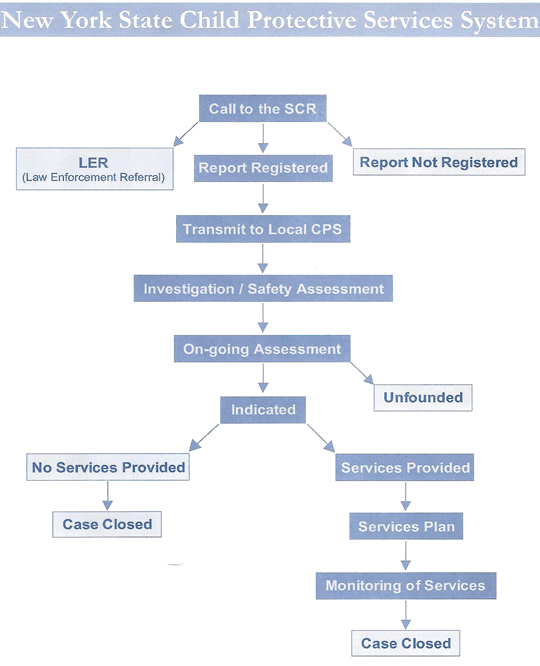|
After taking the report of child abuse or maltreatment/neglect
from a mandated reporter, staff at the SCR, based on the information
provided will make a determination if the report is to be
registered and investigated by the local Child Protective
Service (CPS), if it will be referred to law enforcement or
if the report is not registered (see Figure 2. The New York
State Child Protective Services System).
Figure 2. The New York State Child Protective
Services System

There were 159,556 reports of child abuse and maltreatment
made to the New York State Central Register of Child Abuse
and Maltreatment (SCR), sometimes called the Child Abuse Reporting
Hotline, in 2008 (USDHHS-ACF, 2010). The CPS unit of the local
Department of Social Services is required to begin an investigation
of each report within 24 hours. The investigation should include
an evaluation of the safety of the child named in the report
and any other children in the home, and a determination of
the risk to the children if they continue to remain in the
home. In 2008, upon investigation, 50,989 reports were substantiated
as situations of child abuse and/or neglect. There are more
victims than reports because more than one child is involved
in some cases. In 2008, 108,567 reports of child abuse and
maltreatment/neglect were determined to have been unsubstantiated
(USDHHS-ACF, 2010).
CPS may take a child into protective custody if it is necessary
for the protection from further abuse or maltreatment. Based
upon an assessment of the circumstances, CPS may offer the
family appropriate services. The CPS caseworker has the obligation
and authority to petition the Family Court to mandate services
when they are necessary for the care and protection of a child.
After conducting interviews with family members, the alleged
child victim, and sometimes other people familiar with the
family, the CPS agency makes a determination concerning whether
the child is a victim of abuse or neglect, or is at risk of
abuse or neglect. This determination is often called a disposition.
CPS has 60 days after receiving the report to determine whether
the report is "indicated" or "unfounded". The law requires
CPS to provide written notice to the parents or other subjects
of the report concerning the rights accorded to them by the
New York State Social Services Law. The CPS investigator will
also inform the SCR of the determination of the investigation.
The SCR may refer the report to law enforcement. This may
occur if the "Subject of the Report" is not someone who meets
the legal definition. The perpetrator of the abuse may not
be someone who has the legal responsibility for the child.
In such cases, referrals to law enforcement agencies are made
in order to execute the appropriate legal action. There are
situations in which both law enforcement and CPS will be involved,
depending on who is the subject of the report and the nature
of the injury and if any crimes have been committed.
In some cases, perhaps such as in Case #2 of Juanita, if
the nurse practitioner had decided to report the family to
the SCR, the report may not have been taken by the SCR staff.
This may occur when there is information provided by the mandated
reporter that indicates a more appropriate intervention would
be family resolution or referral to a community resource.
Continue on to
|